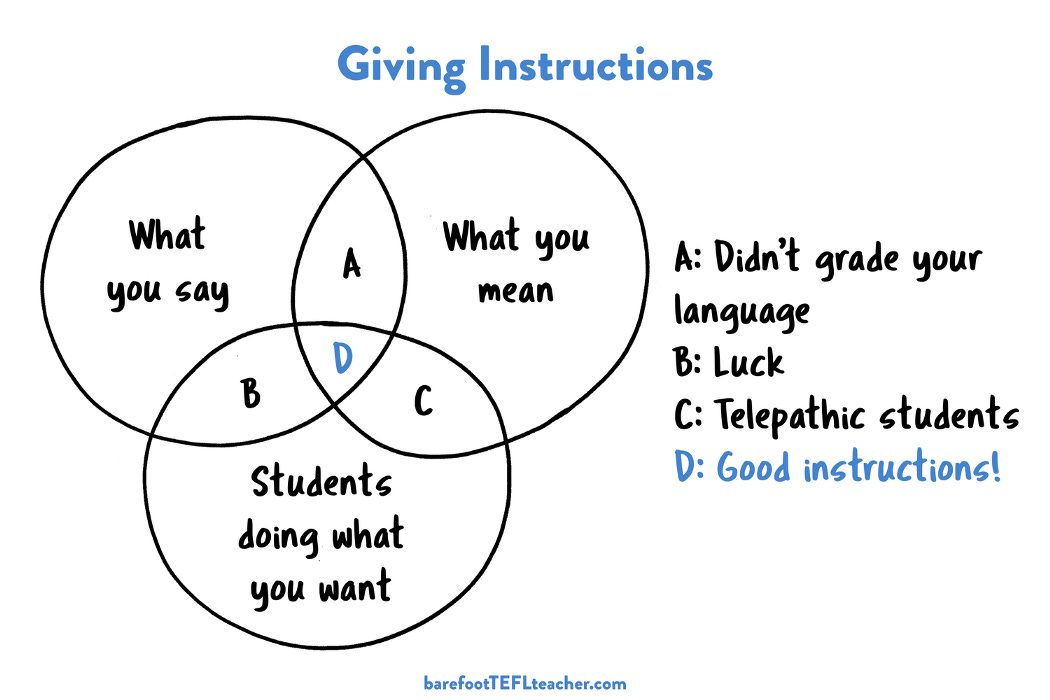4 Steps to Give Great Instructions
Simple to do, easy to remember and always effective.
Giving instructions is crucial to running a successful activity in the classroom.
If you don’t get your instructions spot on, your classroom may well degenerate into something like this;
“Huh? What’sgoingon? Dunno,teachersaid — hey,that’smine-what’s this- Iwouldliketobuy10apples — teacher’spet — likeyourshoes — zzzZZZZZZzzzzzzzz-teachercanigotobathroomplease — OWthathurts — vroomvrommycarisfast — teacherhehitme!-nyah,nyah nya-nya-nyah!….
Or even worse … polite silence.
To make giving instructions easy every time, I like to use a simple process.
The 4 steps for giving instructions
Show ‘em
Tell ‘em
Ask ‘em
Give ‘em
That’s it. Let me explain.
1. Show ‘em
If possible, model the activity. Actually show them what it looks like.
Let the students help you do this. If it's a dialogue, ask a capable student to role-play an example. If it’s a worksheet, show them an example on the board.
You set the standards when you show a perfect example. Setting the standards gives you a higher chance of drawing out better quality work.
‘Show ‘em’ also applies to rearranging students into pairs, small groups, or any seating arrangement. Don’t give the students too much choice, which will paralyse them; decide for them for speed and convenience.
2. Tell ‘em
Plan your instructions. As you plan your lessons, run through what you’ll say in your head or out loud.
Grade your language so that the students will understand you. Are there any words that they won’t understand? Leave out the ‘um, er, yeah, like, OK’ fillers that creep into our daily speech.
Simplify and shorten your instructions. How can you say what you need to in the minimum number of words?
Stage your instructions. Turn them into a list. Hold up your fingers for emphasis as you count through them. Turning instructions into bite-size chunks makes students more likely to remember them.
3. Ask ‘em
You’ve set the stage and filled their ears with instructions. Did they listen? Did they understand? You’d better find out before you tell them to begin.
I’ve always found that “What do I want you to do?” works wonders. You can even tease out an understanding of this for lower-level classes by starting the answer for them, “I want you to…?” and using body language to signal your intent.
If you used a list for your instructions, ask different students for different bullet points. Ensure weaker students understand (but don’t always pick on them to answer, the class will catch on).
Oh, and whatever you do, don’t ask, ‘do you understand?’ Just don’t. Students will either say nothing or ‘yes’ to save face. Either way, you won’t really know if they understand.
4. Give ‘em
Finally, you can give students any necessary worksheets or materials to complete the task.
You can let them re-arrange their chairs if the seating has been rearranged.
Do so beforehand, and watch the attention focused on you evaporate as you’re no longer the most interesting thing in the room.
If you liked this article, you’ll love my books:
📝 Lesson Planning for Language Teachers - Plan better, faster, and stress-free (4.5⭐, 175 ratings).
👩🎓 Essential Classroom Management - Develop calm students and a classroom full of learning (4.5⭐, 33 ratings).
🏰 Storytelling for Language Teachers - Use the power of storytelling to transform your lessons (4.5⭐, 11 ratings).
🤖 ChatGPT for Language Teachers - AI prompts and techniques for language teachers (4.5⭐, 10 ratings).
💭 Reflective Teaching Practice Journal - Improve your teaching in five minutes daily (4.5⭐, 16 ratings).



